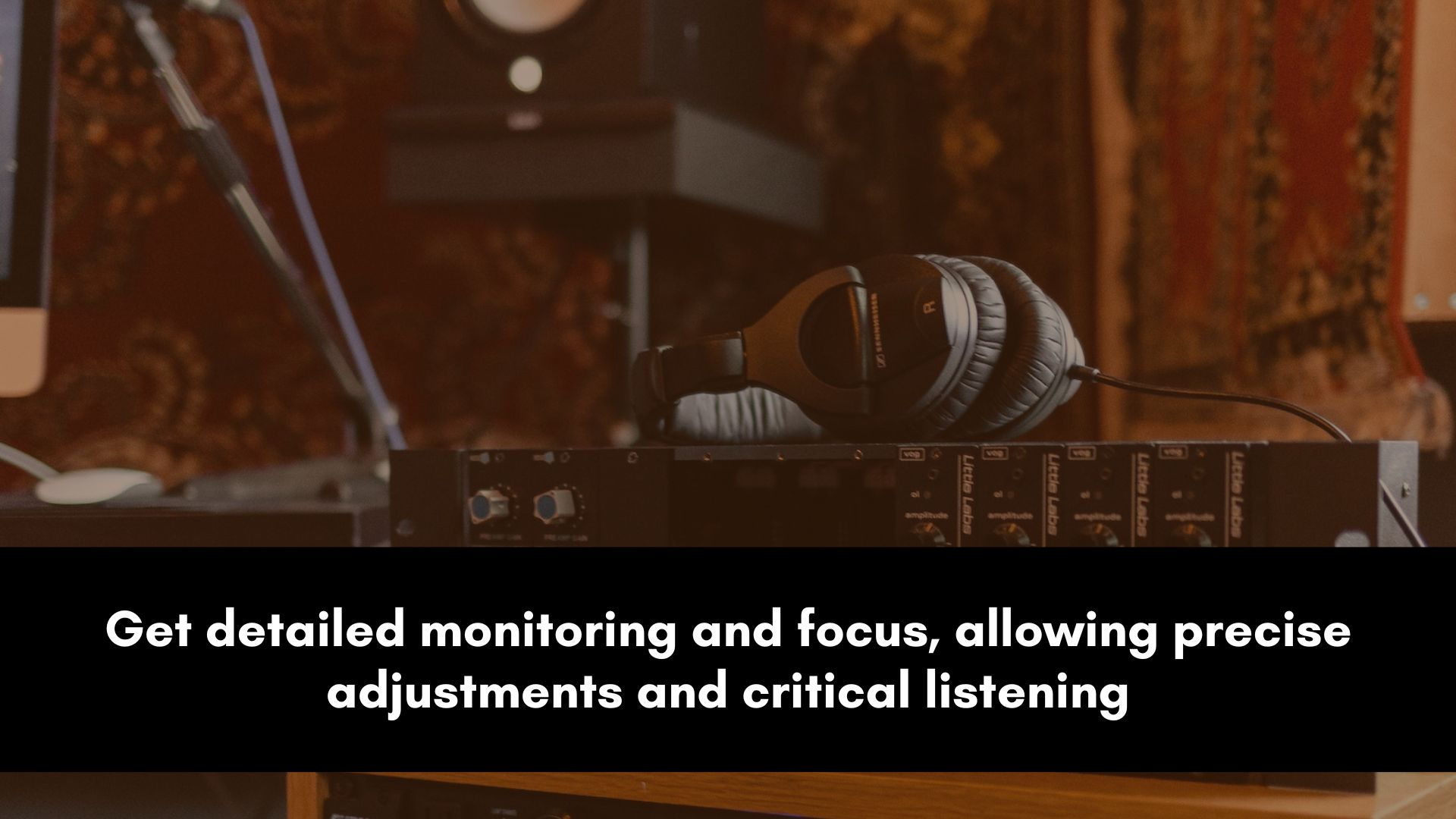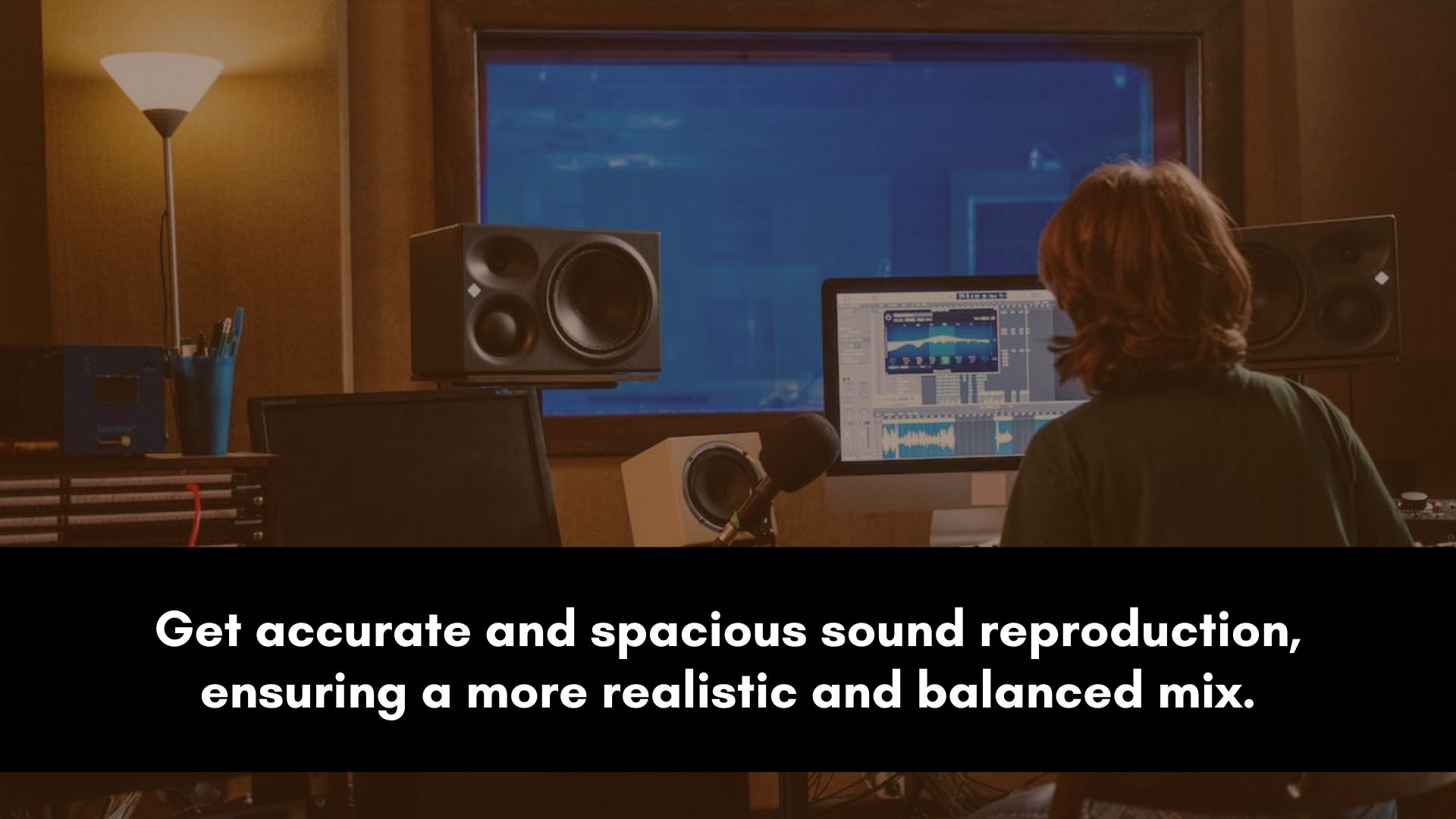Welcome to the ultimate audio showdown: headphones vs. monitors
Brace yourself for a head-to-head clash as we explore the advantages, limitations, and best practices of each contender.
Discover the intricacies of headphone precision and the room-filling magic of studio monitor immersion.
Mixing on Headphones vs Monitors
When it comes to mixing music, choosing the right platform is crucial for achieving accurate and balanced results.
Two common options are mixing on headphones or monitors.
Let’s start by exploring the advantages of using headphones.
Mixing on Headphones

Mixing with headphones offers enhanced detail, allowing you to uncover subtle nuances in your music.
They provide noise isolation, creating a controlled environment free from external distractions.
Headphones are also portable, allowing you to mix on the go.
Here are some advantages to using headphones:
Enhanced Detail
When you slip on a pair of headphones, you enter a world of intricate audio details.
The close and intimate listening experience allows you to pick up subtle nuances that might otherwise go unnoticed.
From the faint whisper of a background instrument to the delicate reverb tails, headphones offer a level of detail that can elevate your mix to new heights.
Noise Isolation
In the chaotic realm of music production, finding a quiet space can be a challenge.
That's where headphones come to the rescue.
By enveloping your ears in their cozy embrace, headphones effectively isolate you from the outside world.
This noise isolation creates a controlled environment where you can focus solely on the mix without any disruptive distractions sneaking in.
Portability
Their portable nature allows you to carry your mixing environment wherever you go.
Whether you're on a plane, in a hotel room, or even at a coffee shop, headphones provide the flexibility to work on your craft without being bound to a specific location.
However, just like with everything, there are some disadvantages to mixing music on headphones.
Here are a couple of disadvantages you need to look out for:
Lack of Natural Acoustics
While headphones excel at revealing minute details, they fall short when it comes to replicating the natural acoustic environment of a room.
Without the reflective surfaces and sonic interactions present in a physical space, headphones can sometimes mislead your perception of stereo image and spatial depth.
It's essential to be aware of this limitation and take measures to compensate for it.
Ear Fatigue
Mixing on headphones for extended periods can take a toll on your ears.
The close proximity of the drivers and prolonged exposure to sound can lead to listener fatigue, causing your ears to become less reliable instruments.
To combat this, it's crucial to take regular breaks during long mixing sessions.
Give your ears a chance to rest and recover, allowing you to maintain objectivity and make better decisions.
Limited Low-End Perception
Bass frequencies are the foundation of many music genres, and accurately reproducing them is vital for a balanced mix.
However, headphones vary in their ability to accurately represent the low end.
Some models might emphasize or downplay certain bass frequencies, leading to imbalances in your mix.
It's crucial to understand your headphones' frequency response and compensate accordingly to ensure a well-rounded low-end presence.
Best Practices For Headphones
Here are some best practices to help you get the most out of your headphone mixes.
Use High-Quality Headphones
Investing in a pair of high-quality headphones is paramount for achieving accurate mixes.
Look for models with a flat frequency response, meaning they reproduce sounds evenly across the entire audible spectrum.
Honestly, you’ll never find one with a flat frequency response.
But with the help of software such as Sonarworks Headphones Reference and dSONIQ by Realphones you can get an accurate flat response.
This will provide a more reliable representation of your mix and help you make informed mixing decisions.
Reference on Multiple Systems
One of the key challenges when mixing on headphones is the risk of creating a mix that only sounds good on headphones.
To avoid this pitfall, it's crucial to reference your mix on multiple playback systems.
This could include listening on studio monitors, car speakers, or even earbuds.
This cross-checking process ensures that your mix translates well across different listening environments and devices.
Take Breaks
Ears need rest, just like any other part of your body.
During long mixing sessions, take regular breaks to give your ears a chance to recover.
Step away from the headphones, stretch your legs, and give your ears a break from the constant sonic bombardment.
This will help prevent ear fatigue and ensure that your decision-making remains sharp and objective throughout the mixing process.
Utilize Virtual Room Simulations
Since headphones lack the natural acoustics of a room, incorporating virtual room simulations can compensate for this deficiency.
Many specialized plugins are available that emulate the acoustic characteristics of different spaces.
By applying these virtual room simulations to your mix, you can regain some of the spatial information lost when mixing solely on headphones.
Experiment with different settings to find a simulation that suits your mix and helps recreate a more realistic listening experience.
Mixing on Monitors

Mixing with studio monitors offers a more accurate representation of the natural acoustic environment.
This creates a wider stereo image and better low-frequency perception.
Monitors allow for precise panning decisions and the creation of an immersive listening experience.
They excel at reproducing bass frequencies with clarity and authority, ensuring a well-balanced mix.
Studio monitors provide a reliable reference for cross-checking mixes and can reveal potential issues that might not be noticeable on headphones.
Here are some advantages to using monitors:
Natural Acoustic Representation
When it comes to mixing on monitors, one of the significant advantages is their ability to provide a more accurate representation of the natural acoustic environment.
Unlike headphones, which can create a more isolated listening experience, monitors allow sound waves to propagate freely in the room.
This helps to recreate the spatial characteristics and interactions that occur in real-world listening scenarios.
Wide Stereo Image
Monitors excel at conveying the width and depth of a mix.
The larger physical drivers and the physical separation between them allow for a more expansive stereo image.
This means you can make precise panning decisions and create a sense of space that feels immersive and realistic.
The wide stereo image provided by monitors can greatly enhance the overall listening experience.
Here are some disadvantages to mixing music on monitors:
Ambient Noise
Speakers require a quiet environment free from external noise.
Unlike headphones, when using monitors, you can pick up ambient sounds from your surroundings, such as computer fans, air conditioners, or street noise.
Minimizing ambient noise ensures that you can accurately hear and evaluate your mix without any unwanted distractions.
Room Acoustics
One of the challenges of mixing with monitors is the impact of room acoustics.
The characteristics of the room, such as its size, shape, and construction materials, can introduce colorations and resonances that affect the sound you hear.
It's crucial to address room acoustics through proper treatment, including bass traps, diffusers, and absorbers, to minimize unwanted reflections and resonances that can negatively impact your mix.
This is more important than any other piece of gear or plugin. Most, if not all, of your budget should go into treating the room.
Space and Cost Limitations
Monitors require dedicated space in your studio setup, along with a financial investment.
Setting up a proper monitoring environment with quality monitors, speaker stands, and room treatment can require a significant budget and sufficient space.
It's important to consider these limitations and determine if you have the necessary resources to accommodate monitors in your mixing setup.
Best Practices For Monitors
Here are a couple of tips that can help you get the best results if your choose to use speakers.
Choose Quality Monitors
Investing in studio-grade monitors with accurate frequency response and low distortion is crucial for reliable monitoring.
Look for models that are specifically designed for audio production and have received positive reviews from professionals.
These monitors will provide a more accurate representation of your mix and allow you to make informed decisions during the mixing process.
Calibrate Your Monitors
To ensure consistent and accurate monitoring, it's important to calibrate your speakers.
Use measurement tools and reference tracks to adjust the volume levels of your monitors, ensuring they are at the optimal listening level.
This calibration process helps establish a reliable baseline for monitoring.
Reference on Headphones
To catch any potential issues or imbalances, it's crucial to cross-reference your mixes on high-quality headphones.
This allows you to evaluate your mix from a different sonic perspective, helping you fine-tune your mix for a wider range of listeners.
Final Verdict
Mixing is an art that requires careful consideration of the tools at your disposal.
Whether you choose to mix on headphones or monitors, each approach offers its own set of advantages and limitations.
Remember, the ultimate goal is to create music that sounds great on any playback system.
Experimentation and cross-checking your mixes on different systems will help you achieve this.
No matter which method you choose, it's crucial to develop your critical listening skills and trust your ears.
It's about finding the approach that works best for your workflow, your listening preferences, and the requirements of your projects.
So, embrace the advantages, overcome the limitations, and use the best practices share above to create professional-grade mixes that captivate your audience.
FAQ:
Do professionals mix with headphones?
Yes, professionals do mix with headphones.
While studio monitors are commonly used for mixing, headphones also play a significant role in the professional audio production workflow.
However, professionals often employ a combination of both headphones and studio monitors to cross-reference.
Utilizing headphones as a valuable tool helps professionals achieve optimal results in their mixing endeavors.
Do you need studio headphones for mixing?
While studio headphones are highly recommended for mixing, they are not an absolute necessity.
Studio headphones are specifically designed to provide accurate and detailed sound reproduction, allowing for precise monitoring and critical listening during the mixing process.
However, if you don't have access to dedicated studio headphones, you can still achieve decent results using high-quality consumer headphones that have a relatively flat frequency response.
The key is to familiarize yourself with the sound characteristics of your headphones and reference your mix on different playback systems to ensure it translates well.
Adaptation and careful listening can help compensate for the lack of studio headphones.
Can you practice mixing using headphones?
Yes, you can practice mixing using headphones.
While it's ideal to have a well-treated studio environment with accurate monitoring, headphones can still serve as a valuable tool for honing your mixing skills.
Also, training your ears and gaining experience with your specific headphones will help you understand their characteristics and make more informed mixing decisions.
Practice, experimentation, and critical listening are keys to mastering your craft.